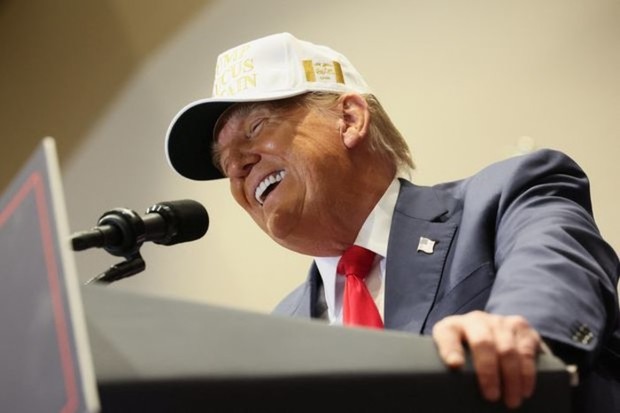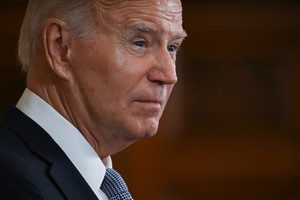When Donald Trump Writes His Ideal Script

It’s theoretically possible that Donald Trump could have gotten more out of Iowa than he did on Monday night. Nikki Haley and Ron DeSantis could have withdrawn from the race and prostrated themselves on the ground at his feet. Jack Smith and Fani Willis could have announced that they were dropping their cases against Trump. Joe Biden could have had a senior moment on live television and forgotten Kamala Harris’ name. Maybe the weather could have been a little better.
But short of such an extraordinary set of occurrences, it’s hard to imagine that there was anything that Trump and his team could have hoped for that they did not receive.
Trump needed to receive over 50 percent of the caucus vote. Check.
He needed DeSantis to edge out Haley for second place to deny her momentum heading into next week’s New Hampshire primary, but not by a large enough margin for the Florida governor to resuscitate his own floundering campaign. And he needed both candidates to be sufficiently encouraged to remain in the race and continue to divide the anti-Trump vote. Double check.
He needed Vivek Ramaswamy to drop out, allowing Ramaswamy’s single-digit support to flow his way heading into New Hampshire. And he needed establishment Republicans and former rivals like Marco Rubio and Doug Burgum to endorse him at the precise moment that Haley was in especially dire need of mainstream support. All of which he got.
Trump did not secure the Republican nomination statistically on Monday night. But he took as large and as decisive a step in that direction as he could have realistically hoped before the caucuses began. Haley and DeSantis will likely continue in the race for now, and both of their campaigns can still make a barely plausible case for an improbable comeback. But those uphill battles are now much steeper than they would have been a few days ago.
DeSantis is now heading to South Carolina, somehow deciding that next month’s primary in Haley’s home state will be the best place for his last stand. Haley is in New Hampshire, where some polls are showing her within single digits of Trump (or at least they were before Iowa weighed in). She already had a very narrow margin of error, even before her disappointing third-place finish on Monday night.
Haley must now either win New Hampshire or lose by no more than a few percentage points, followed by an outright victory in South Carolina. But even those two outcomes would only allow her to survive, and then she would need to follow with another win in Michigan three days later and then somehow compete in no fewer than 16 primaries and caucuses a week after that on March 5. The Trump campaign has been working in these states for months, not just constructing formidable political operations but also changing the delegate selection rules to work to their benefit.
While Haley could potentially overcome these daunting obstacles, it would be as the result of a dramatic comeback, the likes of which have never occurred during the modern political era. Just because something has never happened doesn’t mean that it can’t. But there is no longer any margin of error for Haley at all.
Trump can still be derailed, of course, by legal or actuarial troubles. The most likely Haley or DeSantis scenario at this point is hanging around long enough to see if either a guilty verdict or a health scare can damage the frontrunner in a way that they could not. Both are young enough to consider another presidential run in the future. Both will now be forced to weigh the possibility of Trump being derailed by outside forces against the damage he could do to their future prospects if they stay in the race too long.
Trump’s general election path will be much more difficult than his march to the nomination. His next task will be to find a way to talk with swing voters in a way that will be more convincing than was the case in 2020, trying to explain to them that a president who appointed the three pro-life judges that overturned Roe v. Wade will not do anything else to interfere with abortion rights. Trump has already started edging toward the center on this issue; that shift is about to dramatically accelerate now that he no longer has a primary with which to concern himself.
Want to talk about this topic more? Join Dan for his webinar "Politics In The Time of Coronavirus." Or read more of Dan’s writing at: www.danschnurpolitics.com.
Dan Schnur is a Professor at the University of California – Berkeley, Pepperdine University, and the University of Southern California, where he teaches courses in politics, communications and leadership. Dan is a No Party Preference voter, but previously worked on four presidential and three gubernatorial campaigns, serving as the national Director of Communications for the 2000 presidential campaign of U.S. Senator John McCain and the chief media spokesman for California Governor Pete Wilson. He has a Center bias.
This piece was reviewed and edited by Isaiah Anthony, Deputy Blog Editor (Center bias).
Photo Credit: Brendan McDermid/Reuters via Wall Street Journal

May 9th, 2024

May 7th, 2024

May 7th, 2024